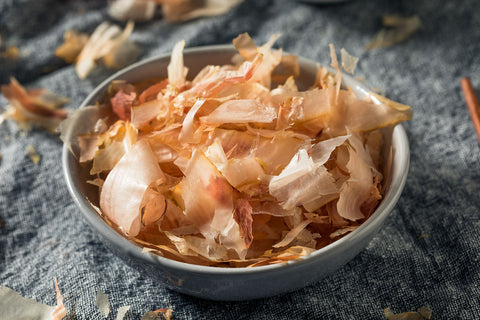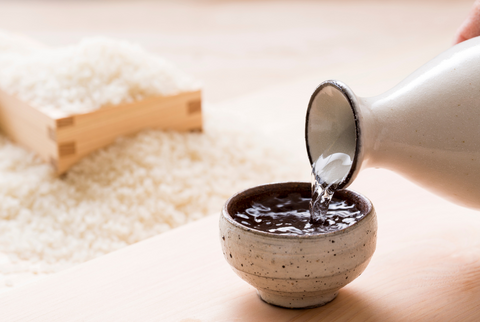
Bonito flakes - known as katsuobushi in Japanese - are a strange food upon first sight. They are known to move or dance when used as a topping on foods such as okonomiyaki and takoyaki. It can be an odd sight upon first viewing if moving food makes you squeamish. However, it is nothing to be alarmed about. The bonito flakes move due to their thin and light structure upon the hot food and are not alive.
Bonito flakes are made from dried bonito fish that is grated into flakes. It's one of the main ingredients in dashi - a staple ingredient used in almost all authentic Japanese dishes.
1. CUTTING
Fresh bonito is cut into 3 pieces (right side, left side, and the spine). From 1 fish, 4 pieces of "Fushi" will be made (Fushi is the dried bonito piece).

2. KAGODATE (placing in a basket)
The bonito will be placed into a basket called "Nikago" which means 'boiling basket'. They will be placed into the boiling basket in an organised fashion, the bonito will be placed in such a way as to boil the fish in the best way. It can't be placed randomly or the fish won't boil correctly.

3. BOILING
The bonito will be boiled at 75–98 degrees centigrade for 1.5hrs to 2.5hrs. The chosen boiling times can vary depending on the fish itself, freshness, size and quality are all taken into account when a professional decides each bonito fish’s unique boiling time. It can take many years of experience to master this. It also depends on the brand of bonito flakes. Each company has a set amount of time that they boil the fish.
4. REMOVING BONES
Once boiling is done, the small bones are removed by hand with tweezers.
5. SMOKING
Once small bones and fish skin is removed, bonitos will be smoked. Cherry blossom and oak are often used as the kindling to smoke bonito. This is repeated between 10 to 15 times.
6. SHAVING THE SURFACE
The tar and fat is then shaved off from the surface of the smoked bonito.

7. DRYING
The Bonito is then baked under the sun for 2 to 3 days, after which some mold is applied on the bonito. This is repeated a few times. After this whole process is completed, 5kg of bonito only becomes around 800-900g of bonito flakes. This whole process takes between 5 months and 2 years.

8. SHAVING
Dried bonito is shaved with a special shaver. The way you shave affects the flakes—if it's shaven incorrectly, it can become powder.
The classic bonito you can currently purchase in shops are flakes that are dried bonito shaved with this special shaver.

How to make dashi with bonito flakes
Boil 1 litre of water, turn off the fire then put 30g of bonito flakes into the boiled water. Leave 1–2 minutes until bonito flakes sink. Filter it and it's done!

Also, in Japan, some other fish are used to make dashi soup:
- Iriko dashi – dashi that is taken from sardine. Often used for miso soup.
- Ago dashi – taken from flying fish. Flying fish have got less fat than other fish so it has less fishy smell in dashi. Used as ramen soup and udon soup.





